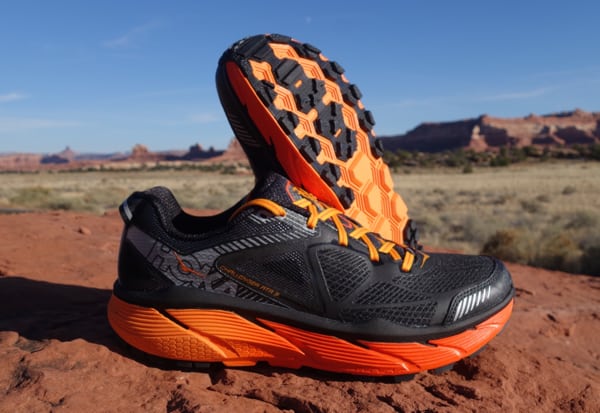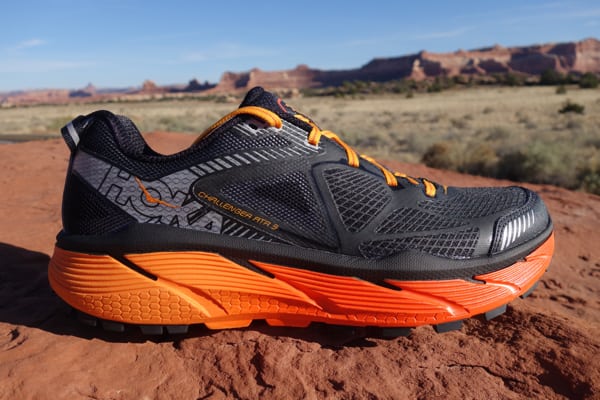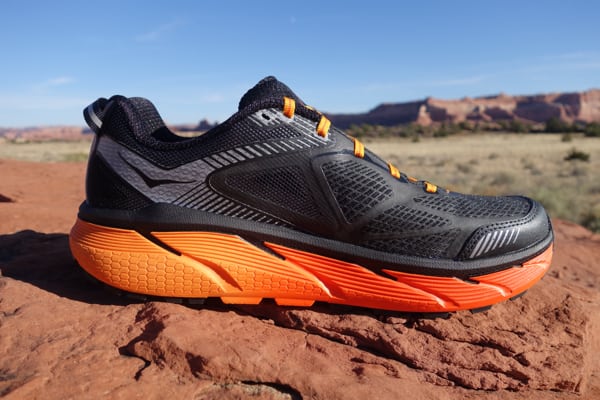Our Favorite Trail Running Shoes
Check out our Best Trail Running Shoes article to learn about our current favorite trail running shoes!
Hoka One One Challenger ATR 3 Review
Running-shoe companies can have the tendency of overcompensating for design flaws on earlier versions of an almost-perfect shoe. I can think of several occasions where a great model was ruined by over engineering or complete design overhauls, which alienate the shoe’s original market. It’s important to understand some of the forces behind shoe design, especially the fact that production schedules are much further down the road than what I’d ever anticipated. For instance, I was a wear tester in the past for a major running-shoe brand and I would often get a model to test three months before it would hit the market. I found this fascinating because my feedback did nothing to change the current model and could only be beneficial to future models. I was always left wondering, “Who tested this first, and why did they think this was a good idea?”
We’ve seen some trail running shoes become barely changing standards over the years, including the Brooks Cascadia, Montrail Mountain Masochist, Salomon S-LAB Sense Ultra, and the now-extinct Pearl Izumi Trail N2. The Hoka One One Challenger ATR 3 ($130) seems primed to join the pantheon of trail running shoe mainstays, which have stayed true to their original design intent and purpose. The original Challenger ATR design featured a stripped-down and airy upper on a very well cushioned, soft-durometer midsole, at under 10 ounces. While this was a highly revered shoe in the ultra community, it did have some vulnerabilities with the upper blowing out and a paper-thin insole. The Challenger ATR 2 fixed these durability issues for the most part but had other fit issues with a lower-volume upper and tight toebox. With this third iteration Hoka seemed to listen intently to its customer base who loved the first two versions but found the fit a bit narrow.

The Hoka One One Challenger ATR 3.
Hoka One One Challenger ATR 3 Upper
For the record, I’ve enjoyed the first two versions of this shoe and I put a lot of miles on them. While I felt crowded in the toebox, the midsole cushioning and light weight were just too good to pass up. With the Challenger ATR 3, Hoka widens the toebox ever so slightly through the metatarsal area. While the toebox still tapers significantly, especially on the lateral side of the shoe, I don’t feel as hemmed in with this version. While I can’t confirm this, it also seems that the slight widening of the upper also widened the overall platform of the shoe, making it the most stable-feeling Challenger ATR to date.
Other changes to the upper include 3D Puff Print overlays, which are basically a system of welded overlays covering the entire mesh upper. This overlay system feels more locked down than past versions of the shoe and they also seem significantly more durable. Hoka retains its effective toe cap, and reflective accents around the heel and toebox are a nice added touch given the hybrid road/trail nature of the shoe. The heel cup is moderately firm and much more stable feeling that the original Hoka Challenger. Hoka also uses some great laces on this new model, which are flat and have just a bit of elasticity to them. They stay tied well and provide some give with foot swelling. A substantial Ortholite insole is a nice touch over the first two versions of this shoe as well.

The Hoka One One Challenger ATR 3’s lateral upper.
Hoka One One Challenger ATR 3 Midsole
I’d complained in the past about the midsole of this shoe compressing over time. It was like 150 miles of absolute bliss followed by denial, and then 100 miles of the realization that the midsole was dead. The new midsole has the same transition and ride but does feel slightly firmer. This could be a figment of my imagination, but I’m close to 200 miles in on my pair and I’m not noticing any deadening of the midsole. I’m also not seeing any telltale signs of midsole wrinkling or compression of any kind. I mentioned before that the platform seems slightly wider, which also gives the Challenger 3 more stability and confidence on technical trails.
On the road the Challenger ATR 3 is a pleasure to run in and, at 9.5 ounces (men’s size 9) with a 5mm heel drop, this shoe can handle faster cadences well. This is a shoe I took out for a 5k turkey trot on Saturday followed by a long trail run on Sunday. This is a great road-to-trail shoe without sacrificing its true trail heritage. I felt more confident on downhills in the Challenger ATR 3 and I never experienced any of that platform-y Hoka sensation that I sometimes get on technical trails.

The Hoka One One Challenger ATR 3’s medial upper.
Hoka One One Challenger ATR 3 Outsole
Why fix it if it ain’t broken? The Challenger outsole remains exactly the same as it ever was. While I originally scoffed at the exposed area of midsole foam in the midfoot, this is an outsole that holds up for 500 miles. It’s also surprising just how well the 4mm lugs hold up and provide ample traction. Though I’ve heard other runners complain of losing lugs, I’m on my fourth pair of Challengers and I’ve never lost a lug or experienced significant wear.

The Hoka One One Challenger ATR 3’s outsole.
Overall Impressions
I think this will be a trail shoe that we’ll see at a lot at ultras throughout 2017. In my opinion, Hoka really nails the design and captures the essence and purpose of this model without going overboard. Since I received this pair to test I’ve had difficulty running in anything else, be it on road or trail. This is a trail shoe that can definitely handle 100 miles and with the slightly wider profile it should accommodate more runners’ feet. I still wouldn’t recommend this shoe for runners needing wide toeboxes, and it does not come in multiple widths at this time.
In my opinion, the Hoka One One Challenger ATR 3 is a must-try for 2017 and it will be tough to beat this shoe out for a ‘best of.’ As of right now, and with all things subject to change with new models coming out, this shoe will be my go-to racing shoe for spring ultras. Hoka really seemed to listen to its customers with this design, creating a more resilient midsole and wider toebox that will make more than a few converts to the brand.
Call for Comments (from Meghan)
- Are you running in the Hoka One One Challenger ATR 3? If so, what are your impressions of this shoe?
- Have you run in previous iterations of the Challenger, too? If so, can you share your thoughts on this model’s updates to the upper, midsole, and toebox that Tom described?
- What other details about this model have you noticed?
[Editor’s Note: If you’re affiliated (i.e., an employee, ambassador, etc.) with brand that produces running shoes, please share your relation in each of your comments on this article. Thanks!]
